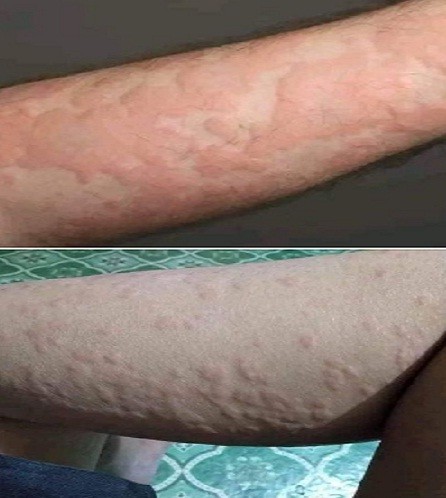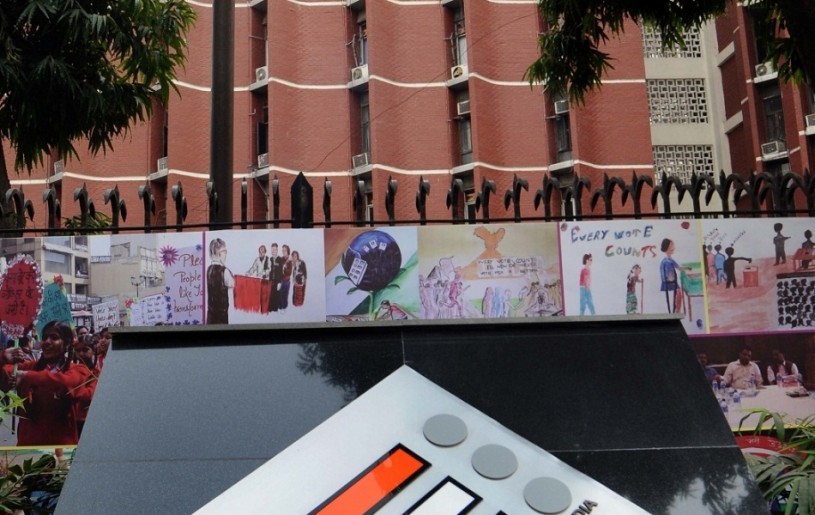Screenshot from a post regarding Lumpy Skin disease on a Nagaland-based Facebook group shared simply with the caption, "Beware..." (Top) The photo of person's hand with apparent skin infection, shared on viral social media implying LSD, pertains to skin rash and was first uploaded on iStock Photo by Getty Images on August 9, 2012, with the caption, "A man's arm covered in a rash from an allergic reaction (steroids and antihistamines cleared it up)" under "Rash due to allergic reaction…’ category. (Bottom) As per Google Images, this photo was uploaded by a user in the comment section of a Thailand-based Facebook page, in a post sharing various skin diseases/rashes/allergies under the caption, "Only those who have this can understand...!!" on April 28, 2019.

- No link with human infections, Veterinary doctors clarify
- Debunk rumours, stress on economic loss
- Suspected cases reported in Nagaland
Moa Jamir
Dimapur | June 17
Amidst the report of another outbreak of lumpy skin disease (LSD) in some states in India, viral images purportedly showing the infection spreading to humans have gone viral in Nagaland. Similar rumours had spread before during previous outbreaks in India.
The immediate trigger this time around was an order concerning the LSD outbreak issued by a district Animal Husbandry & Veterinary Officer in Arunachal Pradesh on June 13.
Accordingly, the viral images are shared with an embedded message, "Do not eat BEEF MEAT. LSD is spreading rapidly everywhere in Arunachal pradesh." (Sic).
The accompanying images show cattle affected with LSD as well as two or three of humans infected with skin diseases, supposedly LSD.
While the images have been widely shared on the WhatsApp platform this week without any caption but letting the photos 'speak for themselves,' on a popular Nagaland-based Facebook group, they were shared simply with the caption, "Beware..."
Of the photos, the first was of a calf with LSD. A simple Google reverse image search revealed that it was first published in Arunachal Observer and seems to be a departmental handout, issued along with the June 13 advisory.
Unrelated Images
However, the other two photographs - of a person's hand and a person's leg with apparent skin infections - have no relation to LSD at all but are making a bigger impact.
A reverse image search of the human hand with an infection on Google Images led to various links dealing with human skin infections and specifically pointed to a skin rash – Hives or urticaria.
It was first uploaded on iStock Photo by Getty Images on August 9, 2012, with the caption, "A man's arm covered in a rash from an allergic reaction (steroids and antihistamines cleared it up)" and categorised under the section, "Rash due to allergic reaction (XXXL) stock photo."
According to TinEye, another image search and recognition company, the photo was first found published on November 18, 2013, on Healthline.com in an article dealing with skin discolouration.
Meanwhile, the photo of a person with a skin infection on the leg seems to be somewhat new.
Searches on Google Images take us to the source of the photo, a Thailand-based Facebook page, in a post sharing various skin diseases/rashes/allergies under the caption, "Only those who have this can understand...!!"
The original post uploaded on April 28, 2019, has been shared over 1.3 million times so far and has over 83,000 comments, with many sharing photos of their skin infections.
Incidentally, as both the photos discussed above are featured on the post, one can safely assert that they were sourced from the same post.
Accordingly, the photos of the skin disease shared, implying LSD infection in humans, are false and not related to the disease. However, as with everything on the web, the photos seem to be shared mischievously to achieve certain objectives.
Nagaland AH&VS Officials debunk LSD-human Link
Meanwhile, two AH&VS doctors in Nagaland contacted by The Morung Express, concurring with experts elsewhere, ruled out the link between LSD and humans and asserted that no such cases have been discovered to date, stating it is not zoonotic in nature.
The images shared on WhatsApp are completely fake and unrelated, one of the doctors categorically asserted. She further ruled out the transmission of LSD to humans.
Such debunking is not isolated. During the last outbreak of the viral skin disease in 2022, rumours flew high in India and several instances of misinformation spread concerning the issue.
Among others, there were many viral social media posts falsely claiming that milk had become unsafe for human consumption due to the spread of LSD or its deadly spread to humans.
Leading news outlets such as Times of India, BBC, The Hindu, Hindustan Times, to name a few, published articles debunking the connection between LSD and humans.
According to a UN Food and Agricultural Organisation (FAO) statement during an outbreak in September 2017, while LSD can be deadly for cattle, it "does not affect humans."
This is still the status. "To date, there is no evidence of any animal-to-human transmission," Dr. KP Singh, Joint Director of the IVRI, told the BBC last October. "However, a suckling calf can get the infection from the milk of an infected cow."
What is real
LSD outbreaks have been reported in some states, and in Meghalaya and Arunachal Pradesh, advisories have been issued to the general public regarding awareness and preventing further infection.
The Nagaland Directorate of AH&VS seems to be in constant surveillance, issuing an advisory on LSD as early as March 2023.
Accordingly, it advised livestock farmers (Dairy, Cattle/Buffalo Ranging, Mithun, etc.) in the state to be vigilant about the occurrence of the disease in animals and report the matter to the nearest Veterinary Centre.
Meanwhile, the AH&VS official told this newspaper on June 17 that there were some suspected cases of LSD in Nagaland in areas along the Dimapur-Chümoukedima-Kohima belt and awaiting lab confirmation.
After the March advisory, the official informed that the department has been on constant surveillance, besides conducting awareness programs and other activities. All districts have been alerted, and standard operating procedures and established protocols would be followed/issued when confirmed cases are reported.
The official further stressed that as morbidity from LSD is high, every stakeholder must ensure reportage as well as prevention of the spread of the infection.
In a way, the current viral rumours, though completely unrelated and false, have created some awareness, the official opined.
As per the AV&HS advisory in March, LSD is caused by the capripox virus, also known as the 'Neethling' virus, "causing devastating economic losses via increased mortality, reduced productivity, control cost, loss in trade, decreased market value & food security.
It affects cattle and buffaloes. It is also a threat to wildlife populations like deer, bison, and Mithun," it said.
The disease causes high fever, reduced milk yield, skin nodules, loss of appetite, nasal & eye discharges, and formation of nodules on the body transmitted by flies, ticks, and mosquitoes, it added.
The disease causes high fever, reduced milk yield, skin nodules, loss of appetite, nasal & eye discharges, and formation of nodules on the body transmitted by flies, ticks, and mosquitoes, it added.
According to the FAO, the vector-borne disease of cattle and Asian water buffalo is included on the OIE (World Organisation for Animal Health) list of notifiable diseases and was first recorded in Zambia in 1929.
In the 1940s, the disease spread to other southern African countries and other parts of the world.
In July 2019, LSD was introduced to Bangladesh, China, and India and then spread to Nepal and Bhutan and in 2020 to various provinces of China and India.
In December 2022, the Union Ministry of Fisheries, Animal Husbandry & Dairying informed National Centre for Veterinary Type Culture, ICAR-National Research Centre on Equines (ICAR-NRCE), Hisar (Haryana), in collaboration with ICAR-Indian Veterinary Research Institute (IVRI), Izatnagar (UP) developed a homologous live-attenuated LSD vaccine, named Lumpi-ProVacInd.
Agrinnovate India Limited (AgIn), the commercial arm of DARE, Ministry of Agriculture and Farmers’ Welfare, GOI has granted “Non-Exclusive Rights” for Commercial production of “Lumpi-ProVac”, to Institute of Veterinary Biological Products (IVBP) , Pune, it added.






